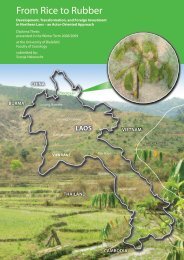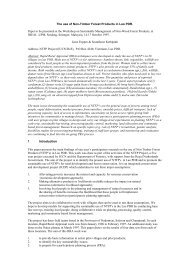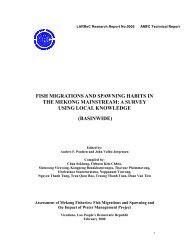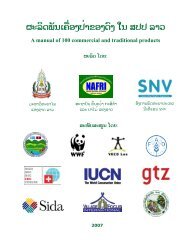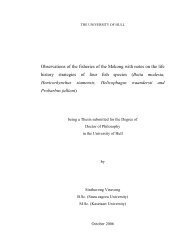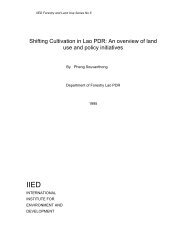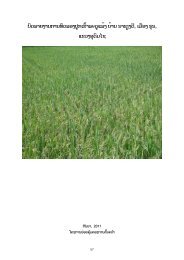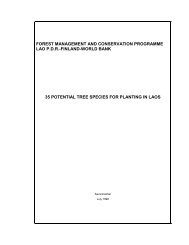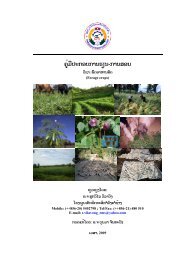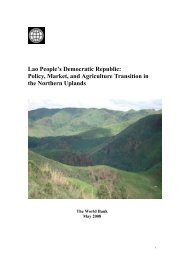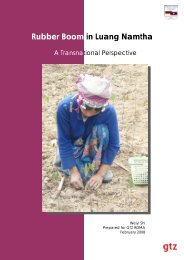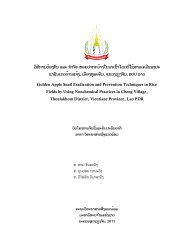improved fallow systems in the luang prabang area, lao pdr - Afaci
improved fallow systems in the luang prabang area, lao pdr - Afaci
improved fallow systems in the luang prabang area, lao pdr - Afaci
Create successful ePaper yourself
Turn your PDF publications into a flip-book with our unique Google optimized e-Paper software.
Improved <strong>fallow</strong> <strong>systems</strong> <strong>in</strong> <strong>the</strong> Luang Prabang <strong>area</strong>, Lao PDR – an analysis based on farmer experiencesResultsResultsThe results presented here are almost entirely a product of <strong>the</strong> farmer <strong>in</strong>terviews. Important partsof <strong>the</strong>se data cannot be quantified and are more impressions and op<strong>in</strong>ions discussed dur<strong>in</strong>g <strong>the</strong>meet<strong>in</strong>gs. Ma<strong>in</strong> trends presented below are an <strong>in</strong>terpretation of <strong>the</strong>se discussions.Implementation and adaptationIn <strong>the</strong> SCRP experiments, plots were ma<strong>in</strong>ly cropped with rice <strong>in</strong> 1992. Toge<strong>the</strong>r with <strong>the</strong> rice,rows of Leucaena or alternat<strong>in</strong>g rows of Leucaena and Pigeon pea were planted. Spac<strong>in</strong>g wastypically 0.5 to 1 meter <strong>in</strong> <strong>the</strong> rows with 5 to 10 meters between rows. In some cases grasses(ma<strong>in</strong>ly Stvlo) were broadcast after weed<strong>in</strong>g <strong>the</strong> plot. Most farmers expressed a view that <strong>the</strong>implementation of <strong>the</strong> system cost <strong>the</strong>m some extra plant<strong>in</strong>g work.Typically, <strong>the</strong> plots were <strong>the</strong>n left <strong>fallow</strong> for two or three years after this, until used aga<strong>in</strong> on <strong>the</strong>third or fourth year after implementation. Almost half <strong>the</strong> number of plots were used <strong>in</strong> a thirdcropp<strong>in</strong>g period <strong>in</strong> 1998 or 1999. For <strong>the</strong>se years. Job's Tears were <strong>the</strong> ma<strong>in</strong> crop at almost allexperimental plots. Usually. Leucaena and Pigeon pea were cut to between 0.5 and 1 meterbefore burn<strong>in</strong>g of <strong>the</strong> plot.Two farmers <strong>in</strong> Ban Dan present an <strong>in</strong>terest<strong>in</strong>g exception from this pattern. Here, rice was grownwith alternat<strong>in</strong>g rows of Leucaena and Pigeon pea for two years. In <strong>the</strong> third year, beans (blackseeded Cow pea and Soybean) were grown between <strong>the</strong> rows. Branches and leaves from <strong>the</strong>Leucaena and Pigeon pea were put <strong>in</strong> <strong>the</strong> rows to reduce erosion. Probably, attempts were madeto implement alley cropp<strong>in</strong>g (a form of permanent agriculture) here. but <strong>the</strong> fields were left to<strong>fallow</strong> aga<strong>in</strong> after three years and <strong>the</strong> <strong>systems</strong> became <strong>improved</strong> <strong>fallow</strong> <strong>systems</strong>.The FAO/LJNDP plots are <strong>in</strong> most cases <strong>in</strong>itially Leucaena plantations, with no o<strong>the</strong>r crop <strong>in</strong> <strong>the</strong>first years, planted between 1984 and 1987. Some of <strong>the</strong>se have been used for cropp<strong>in</strong>g s<strong>in</strong>ce<strong>the</strong>n and are of <strong>in</strong>terest to this study, while o<strong>the</strong>rs have been left to become small Leucaenaforests. In 1988, plantations were started <strong>in</strong> a number of extension villages. Here, Leucaena wasgrown toge<strong>the</strong>r with rice <strong>in</strong> <strong>the</strong> first year. Spac<strong>in</strong>g <strong>in</strong> <strong>the</strong> earlier plantations was about 1x10meters, while it was denser <strong>in</strong> later plantations.These plots have <strong>in</strong> most cases gone through several cycles of <strong>fallow</strong> and cropp<strong>in</strong>g. A usualcycle seems to be about five years, but most plots have been used for two years <strong>in</strong> a row at leastonce.Usually, <strong>the</strong> plots do not offer any special weed<strong>in</strong>g problems. Typically, new germ<strong>in</strong>ations ofLeucaena and Pigeon pea are weeded quite easily and new branches on old Leucaena are cutwithout major effort. The only ma<strong>in</strong> problem seems to have been <strong>the</strong> <strong>in</strong>troduced grasses. Thesecan be very competitive and offer most farmers extra weed<strong>in</strong>g work.Yield and <strong>fallow</strong>It seems as if an overwhelm<strong>in</strong>g majority of <strong>the</strong> farmers are conv<strong>in</strong>ced that plant<strong>in</strong>g Leucaena andPigeon pea is good for <strong>the</strong>ir plots, and <strong>the</strong>y all say that it gives <strong>the</strong>m better yields than traditional,un<strong>improved</strong>, methods.When look<strong>in</strong>g at <strong>the</strong> yield data given by <strong>the</strong> farmers it is hard to f<strong>in</strong>d grounds for <strong>the</strong>ir positivestatements, which leads one to suspect that <strong>the</strong>y give an answer <strong>the</strong>y th<strong>in</strong>k might please. Whenasked why all farmers <strong>in</strong> <strong>the</strong> village do not use <strong>the</strong> method (if it is so good), <strong>the</strong> extra work atimplementation is sometimes used as an explanation. However hard it may be to believe such apositive picture of <strong>the</strong> methods, <strong>the</strong> farmers usually <strong>in</strong>sist that it is so.IMPROVED FALLOW SYSTEMS IN THE LUANG PRABANG AREA, LAO PDR - AN ANALYSIS BASED ON FARMEREXPERIENCES.20040940 8



